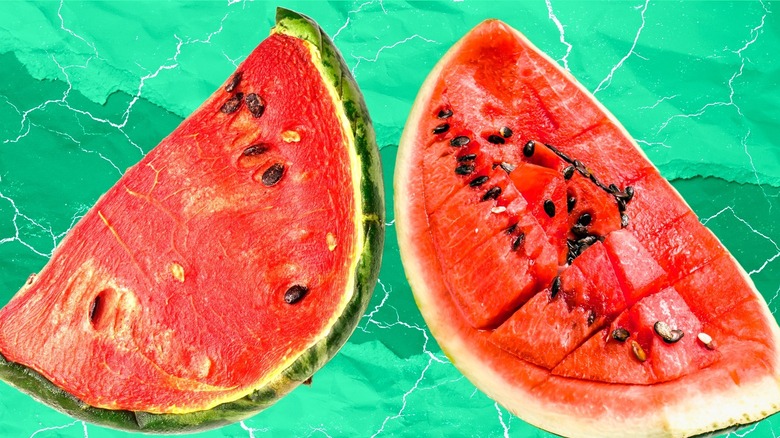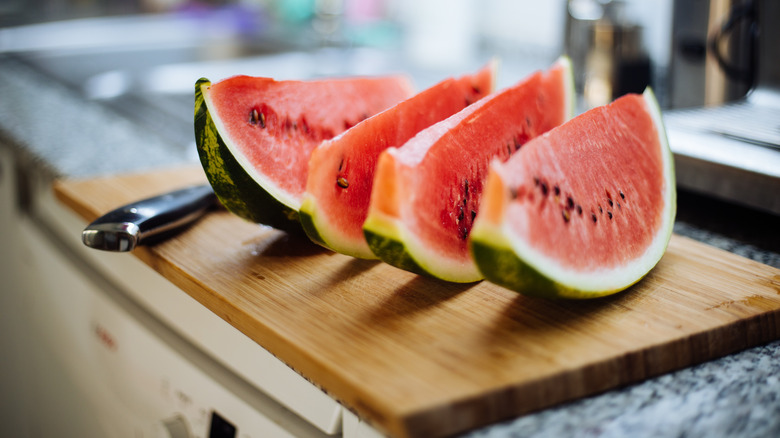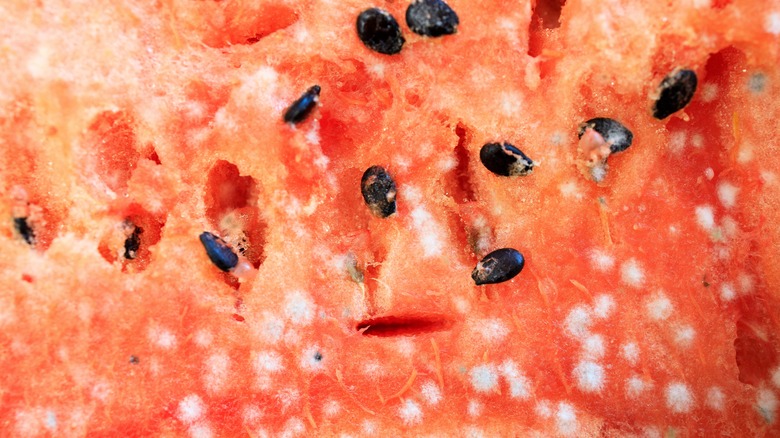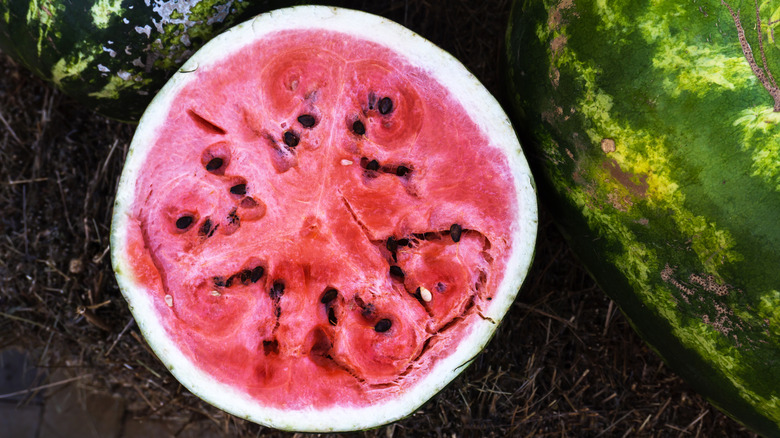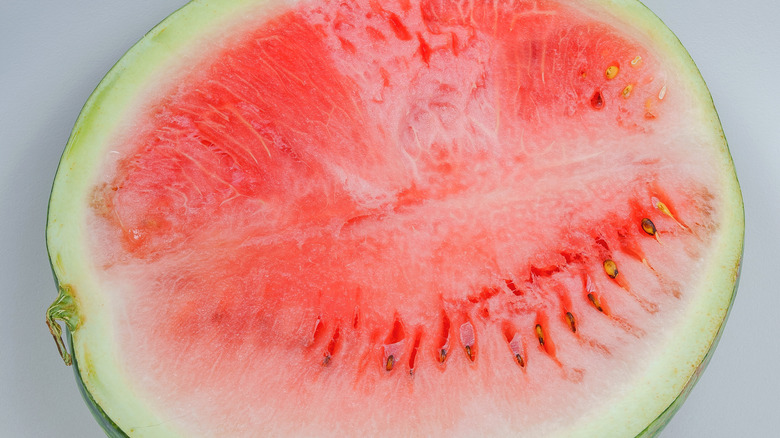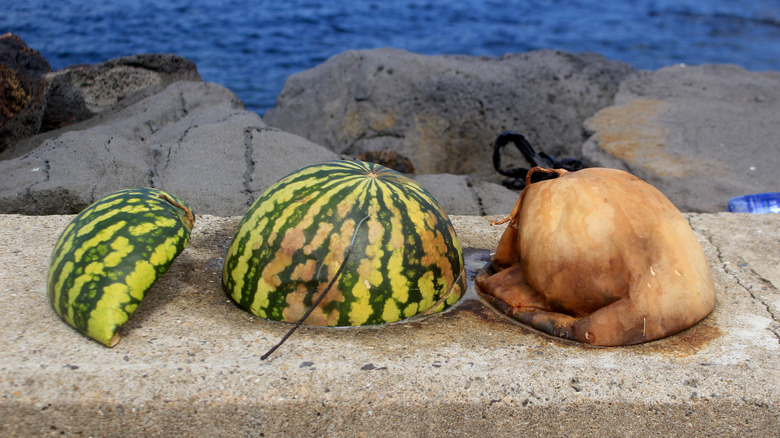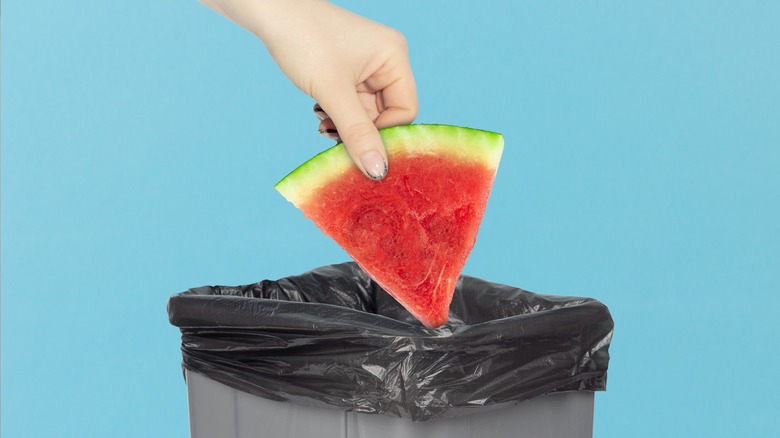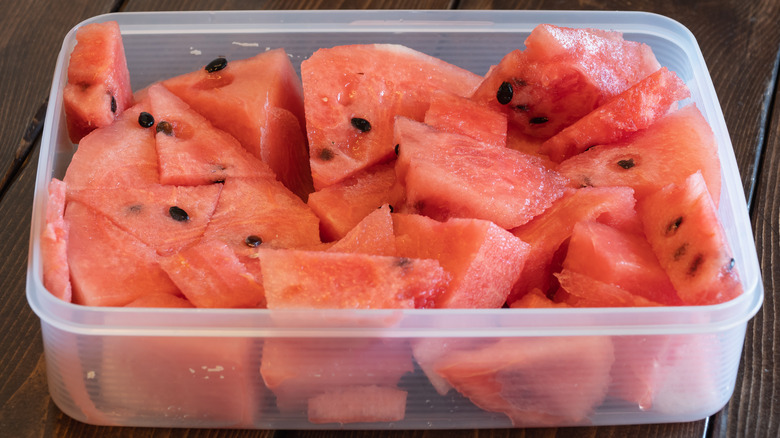Warning Signs Your Watermelon Has Gone Bad
When watermelon is ripe and fresh, it has a super sweet taste and a crisp, juicy texture perfect for enjoying on hot summer days. However, the window for peak freshness may be somewhat shorter than you'd expect. In just a short amount of time, the flavor and feel of watermelon start to change and spoil, signaling that it has gone bad. Once this juicy fruit has turned, it loses its yummy taste and begins to show noticeable warning signs of spoilage, indicating that it is no longer suitable to eat.
In addition, there are a few things you can do to help preserve freshness and prevent it from going bad before you get a chance to devour it. To ensure you eat watermelon when it tastes the best, you need to know how long it stays fresh, how to store it properly, and how to monitor the appearance, texture, smell, and taste, so you know when it is overripe or ready for the trash. Keep reading to learn about all the different warning signs your watermelon has gone bad.
How long does watermelon stay fresh?
Depending on how it is stored, whether cut or whole, and when it is harvested, watermelon stays good for anywhere from one day to four weeks after being picked. That may seem like a broad range, but there are a lot of variables to consider. After being cut off of the vine, a whole watermelon stays good for about three to four weeks, but it takes some time to get to the store.
As a general rule of thumb, whole watermelons you buy at the grocery store stay good for seven to 10 days when kept at room temperature or two to three weeks when chilled. Chopped watermelon lasts approximately four to seven days before it goes bad. You can increase your chances of achieving the higher end of this range if you cover it securely and keep it in the fridge.
If you purchase pre-cut watermelon from the store, it comes with a clearly stated sell-by date, so you have a pretty good idea of how long it will stay fresh. Sell-by dates aren't the same as an expiration date, but they are a good indicator that pre-cut watermelon will go bad soon. Pre-cut watermelon lasts for about one day when left out of the fridge, but when chilled, you are likely to get another two or three days of freshness before it actually needs to be tossed out.
Mold growing on the fruit
Visible mold growing on the fruit of a watermelon is typically the most obvious warning sign that it has gone bad. If this happens, throw it out immediately. Just like with any kind of food, you never want to eat watermelon if it develops mold, either on the flesh or the rind. Typically, it will grow on the fruit first. Additionally, mold grows much faster on cut pieces of watermelon than on a whole watermelon, which is just one of the reasons it is best to leave your fruit whole until you are ready to eat it.
Mold grows on the fruit of a watermelon in the form of small white, black, or brown dots. If you accidentally eat moldy watermelon, it can easily make you sick. In fact, even smelling mold can cause adverse reactions. According to the Rhode Island Department of Health, exposure to an abundance of mold spores can lead to a myriad of allergic symptoms like coughing, sneezing, headache, watery eyes, runny nose, or even difficulty breathing. They also note that repeated exposure to mold spores can result in increased sensitivity and more extreme reactions, so always play it safe.
The inside develops large cracks or ditches around the seeds
When the meaty interior of a watermelon starts forming larger cracks around the seeds, it is a surefire sign that it is becoming overripe and well on its way to spoiling. At this point in the decomposition process, your watermelon may still be edible. However, it probably won't be for long, so make sure to eat it as quickly as possible.
Big cavities in the flesh of a watermelon, even if they are not surrounding the seeds, are another sign that it is overripe and starting to go bad. Ideally, the fruit in a watermelon will be relatively smooth and consistent, so if this starts to change, you immediately know something is not right. Instead of tossing it out right away, try adding it to a blended drink or putting it in your favorite vodka, rum, or tequila to infuse your next drink with fresh, summery flavor.
The fruit dries out and has a gritty texture
The meat of an overripe watermelon stops having a crisp, juicy texture and starts to feel dry and gritty. When the fruit dries out, it may also develop a milkier color than the bright red or pink you know and love, which is another sign it is starting to spoil. If your watermelon has already been cut into cubes or slices, the fruit will also begin to lose its shape as the water inside the fruit drains out. If it starts to look deflated or you notice more juice in the bottom of the storage container, these are also signs it is going bad.
When this happens, it is still safe to eat your watermelon, even if the feel of it isn't as crisp. However, you should expect it to go bad fairly quickly. Before it's too late, try mixing it into a blended drink or a cocktail like a watermelon sangria, where the flavor and texture aren't as important. Once watermelon passes the point of feeling mealy and dry and becomes rotten, it will start feeling mushy or slimy. Don't try to salvage it if it gets to this point. Unfortunately, throwing it away will be your only option.
A dull, soft, or discolored rind
The rind of a ripe watermelon will have distinguishable lines and darker coloring between them. If the shell on your watermelon starts to become dull and the stripes become less distinct, these are clear warning signs that it is going bad. If you notice this happening, eat it as soon as possible, or it may be too late. If it gets to the point when you can see dark spots on the rind, it's most likely too far gone, and it's time to throw it away.
In addition to the appearance, the rind on a ripe watermelon should have a firm surface. If you check the firmness of a shell and it isn't taught or feels somewhat soft, these are warning signs that it is starting to go bad. If you pick up a watermelon and your fingers leave indents in the rind, it is likely too far gone to eat. Lastly, if you can see visible soft spots on the shell without even touching it, it is definitely time for the trash.
The smell becomes sour or tangy
Just like with taste, ripe watermelon has a fresh, sweet smell when it is ripe. When it starts to over-ripen, the smell changes, which is a good sign that it is beginning to go bad. Assessing the smell of a whole watermelon isn't always super obvious because of the thick rind. However, if you sniff the base of the melon's peel where the stem came out and it has a dank or fermented odor, chances are good that it has spoiled. Still, it would be best if you cut it open for further investigation before deciding to toss it in the trash.
With cut watermelon, a foul smell or changing odor is much easier to identify. When you smell chunks of watermelon, they should smell sweet and bright. If they start losing their scent, it's a sign that they are overripe. Further down the line, they may even have a sour or tangy aroma. If it gets to this point, it is time to throw them out.
The taste ranges from bland to slightly sour
Almost everyone loves the taste of watermelon at peak freshness. When eaten at the ideal time, watermelon is mouth-wateringly sweet and fruity while still being somewhat light. Once a melon passes peak freshness, its much-loved flavor starts to diminish quickly, and eventually, it becomes quite bland. As this happens, it also starts becoming mushy, leading to a dry, overly sweet flavor profile that is unpleasant. While it still may be okay to eat at this point, it certainly won't be as enjoyable. If you still think it is worth a try, combining it with other ingredients in a smoothie or blended drink is your best bet.
If watermelon becomes rotten, the taste changes yet again, and it develops a sour or rancid taste. Whichever stage it is in, overripe and spoiled watermelon will likely have an unappetizing flavor. So, if you give it a small taste test and don't like the flavor, trust your instincts and throw it in the garbage. Chances are, no one else will like it either.
How to keep watermelon as fresh as possible
If you don't plan on eating a watermelon the day you buy it, there are several things you can do to help keep it fresh for longer. To start, you want to buy a good watermelon. Ideally, you want to purchase a watermelon with a firm rind with a yellow ground spot, a heavy weight, a hollow sound, and two finger-width stripes.
Once you've selected your watermelon and brought it home, it's best to keep it whole until you're ready to eat it. Chilling your watermelon also helps slow down the ripening process. While storing an entire watermelon on the counter away from direct sunlight is more than acceptable, putting the whole thing in the fridge will keep it fresher for an extended period of time.
Once cut, watermelon ripens and loses freshness at a rapid pace. To keep cut watermelon fresh for as long as possible, you want to chill it right away. You also want to cover it with plastic wrap or put it in an airtight container before placing it in the fridge. Just like when it is whole, keeping your cut watermelon cool will help it maintain freshness for longer.
